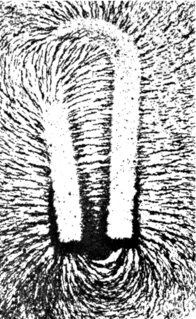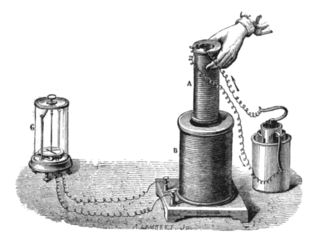
An electromagnetic field is a magnetic field produced by moving electrically charged objects. It affects the behavior of non-comoving charged objects at any distance of the field. The electromagnetic field extends indefinitely throughout space and describes the electromagnetic interaction. It is one of the four fundamental forces of nature.

An inductor, also called a coil, choke, or reactor, is a passive two-terminal electrical component that stores energy in a magnetic field when electric current flows through it. An inductor typically consists of an insulated wire wound into a coil around a core.

Magnetism is a class of physical phenomena that are mediated by magnetic fields. Electric currents and the magnetic moments of elementary particles give rise to a magnetic field, which acts on other currents and magnetic moments. The most familiar effects occur in ferromagnetic materials, which are strongly attracted by magnetic fields and can be magnetized to become permanent magnets, producing magnetic fields themselves. Only a few substances are ferromagnetic; the most common ones are iron, cobalt and nickel and their alloys. The prefix ferro- refers to iron, because permanent magnetism was first observed in lodestone, a form of nature iron ore called magnetite, Fe3O4.

A magnetic field is a vector field that describes the magnetic influence of electric charges in relative motion and magnetized materials. The effects of magnetic fields are commonly seen in permanent magnets, which pull on magnetic materials and attract or repel other magnets. Magnetic fields surround and are created by magnetized material and by moving electric charges such as those used in electromagnets. They exert forces on nearby moving electrical charges and torques on nearby magnets. In addition, a magnetic field that varies with location exerts a force on magnetic materials. Both the strength and direction of a magnetic field vary with location. As such, it is described mathematically as a vector field.

A magnet is a material or object that produces a magnetic field. This magnetic field is invisible but is responsible for the most notable property of a magnet: a force that pulls on other ferromagnetic materials, such as iron, and attracts or repels other magnets.

Electromagnetic or magnetic induction is the production of an electromotive force across an electrical conductor in a changing magnetic field.

A solenoid is a type of electromagnet, the purpose of which is to generate a controlled magnetic field through a coil wound into a tightly packed helix. The term was invented in 1823 by André-Marie Ampère to designate a helical coil.
In electromagnetism, the magnetic susceptibility is a measure of how much a material will become magnetized in an applied magnetic field. Mathematically, it is the ratio of magnetization M to the applied magnetizing field intensity H. This allows a simple classification of most materials' response to an applied magnetic field into two categories: an alignment with the magnetic field, χ>0, called paramagnetism, or an alignment against the field, χ<0, called diamagnetism.
In physics, the magnetomotive force (mmf) is a quantity appearing in the equation for the magnetic flux in a magnetic circuit, often called Ohm's law for magnetic circuits. It is the property of certain substances or phenomena that give rise to magnetic fields:
The tesla is a derived unit of the magnetic induction in the International System of Units.
A magnetic circuit is made up of one or more closed loop paths containing a magnetic flux. The flux is usually generated by permanent magnets or electromagnets and confined to the path by magnetic cores consisting of ferromagnetic materials like iron, although there may be air gaps or other materials in the path. Magnetic circuits are employed to efficiently channel magnetic fields in many devices such as electric motors, generators, transformers, relays, lifting electromagnets, SQUIDs, galvanometers, and magnetic recording heads.
A magnetic core is a piece of magnetic material with a high magnetic permeability used to confine and guide magnetic fields in electrical, electromechanical and magnetic devices such as electromagnets, transformers, electric motors, generators, inductors, magnetic recording heads, and magnetic assemblies. It is made of ferromagnetic metal such as iron, or ferrimagnetic compounds such as ferrites. The high permeability, relative to the surrounding air, causes the magnetic field lines to be concentrated in the core material. The magnetic field is often created by a current-carrying coil of wire around the core.

Electromagnetic shielding is the practice of reducing the electromagnetic field in a space by blocking the field with barriers made of conductive or magnetic materials. Shielding is typically applied to enclosures to isolate electrical devices from their surroundings, and to cables to isolate wires from the environment through which the cable runs. Electromagnetic shielding that blocks radio frequency (RF) electromagnetic radiation is also known as RF shielding.
The physical constant ε0, commonly called the vacuum permittivity, permittivity of free space or electric constant or the distributed capacitance of the vacuum, is an ideal, (baseline) physical constant, which is the value of the absolute dielectric permittivity of classical vacuum. It has the CODATA value
The physical constant μ0,, commonly called the vacuum permeability, permeability of free space, permeability of vacuum, or magnetic constant, is the magnetic permeability in a classical vacuum. Vacuum permeability is derived from production of a magnetic field by an electric current or by a moving electric charge and in all other formulas for magnetic-field production in a vacuum.
In petroleum engineering, a Klinkenberg correction is a procedure for calibration of permeability data obtained from a minipermeameter device. A more accurate correction factor can be obtained using Knudsen correction. When using nitrogen gas for core plug measurements, the Klinkenberg correction is usually necessary due to the so-called Klinkenberg gas slippage effect. This takes place when the pore space approaches the mean free path of the gas

An electromagnetic lock, magnetic lock, or maglock is a locking device that consists of an electromagnet and an armature plate. There are two main types of electric locking devices. Locking devices can be either "fail safe" or "fail secure". A fail-secure locking device remains locked when power is lost. Fail-safe locking devices are unlocked when de-energized. Direct pull electromagnetic locks are inherently fail-safe. Typically the electromagnet portion of the lock is attached to the door frame and a mating armature plate is attached to the door. The two components are in contact when the door is closed. When the electromagnet is energized, a current passing through the electromagnet creates a magnetic flux that causes the armature plate to attract to the electromagnet, creating a locking action. Because the mating area of the electromagnet and armature is relatively large, the force created by the magnetic flux is strong enough to keep the door locked even under stress.











